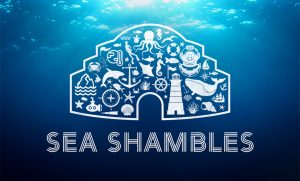Sunset Ribbons
Sea Shambles Advent Calendar - Day 5December 5th
When does a sunset not look like a sunset?

Today’s pictures come as a pair, one from @IanMStuart and one from @Bevlarh. Both show a sunset, and both also show a beautiful ribbon of sparkly ocean stretching shoreward from the sun. A sunset picture would just look wrong without that ribbon. But in the first picture it’s sharp and thin, and in the second it’s broad and messy around the edges. You can see these paths of light whenever you’re looking across at a bright light that’s low down relative to the water, and they’re known as glitter paths. I love them, not just because they’re pretty but because they can tell you about things that you can’t see directly (and so some pretty serious science has also come out of them).

Back in 1951, two scientists called Charles Cox and Walter Munk looked into the mathematics of glitter paths and realised that nature had provided a tool for measuring the sea surface, if you knew how to use it. These bands of light are called glitter paths because the spots of light come and go, temporarily glinting as the waves catch the sunlight, but the light only comes from a clearly defined region. If the water surface is flat calm, without any waves, the only reflections that can reach your eyes come from a very narrow band because there are no waves to bounce the light sideways. But if the water surface is rough, light can travel sideways slightly from the sun and can then be bounced back into your eyes from a position some distance from the central line. So the glitter path is broader when the sea is rougher. Cox and Munk realised that there’s a very precise relationship between the angle of the sun, the glinting pattern on the water, and the steepness of the waves. The sun is at different angles in the two images above so it’s hard to compare them directly, but in the third picture below you can see the glitter path varying in width at different distances from the shore.
The Cosmic Shambles Network relies on your support on pledges via Patreon so we can continue to provide great, new, exciting content without the need for third party ads or paywalls.
For as little as $1 a month you can support what we do and get some great rewards for doing so as well. Click the Patreon logo to pledge or find out more.
We see these bands of light all over the place, and we know how to interpret them from experience – thin bright reflections mean that a car is newly polished, or that someone’s hair is super-smooth.
But this bit of physics has a far more practical application. There are satellites orbiting the Earth that send a radar pulse down to the ocean surface and measure the reflections that come back (called satellite altimeters). Using similar principles to the glitter path, scientists can use the radar reflection to estimate how rough the ocean is. Then they can use that to estimate wind speed – if the sea is rough, the reflection is a bit more spread out. Those measurements of global wind speed out over the open ocean (where there are no weather stations) provide important inputs for our weather prediction models. So next time you see a weather forecast, spare a thought for the glittering inputs that help it work.
See what lies behind all the windows of the Sea Shambles Advent here.
 Sea Shambles is a one night only live extravaganza celebrating the oceans. Hosted by Robin Ince and Helen Czerski with Steve Backshall, British Sea Power, Josie Long, Lemn Sissay and more it’s a night of science, comedy, music, lasers and more in which we’ll be turning the Royal Albert Hall into an underwater playground the likes of which you’ve never seen! May 17 2020. Tickets start at just £10! Book here.
Sea Shambles is a one night only live extravaganza celebrating the oceans. Hosted by Robin Ince and Helen Czerski with Steve Backshall, British Sea Power, Josie Long, Lemn Sissay and more it’s a night of science, comedy, music, lasers and more in which we’ll be turning the Royal Albert Hall into an underwater playground the likes of which you’ve never seen! May 17 2020. Tickets start at just £10! Book here.
 Dr Helen Czerski is a physicist, first and foremost, but she’s acquired a few other labels along the way: oceanographer, presenter, author and bubble enthusiast. A regular on The Cosmic Shambles Network, she has also presented a number of acclaimed documentaries for the BBC and Fully Charged. Recently she was awarded the prestigious William Thomson, Lord Kelvin Medal and Prize from the Institute of Physics.
Dr Helen Czerski is a physicist, first and foremost, but she’s acquired a few other labels along the way: oceanographer, presenter, author and bubble enthusiast. A regular on The Cosmic Shambles Network, she has also presented a number of acclaimed documentaries for the BBC and Fully Charged. Recently she was awarded the prestigious William Thomson, Lord Kelvin Medal and Prize from the Institute of Physics.
If you would like to reuse this content please contact us for details
Subscribe to The Cosmic Shambles Network Mailing list here.
The Cosmic Shambles Network relies on your support on pledges via Patreon so we can continue to provide great, new, exciting content without the need for third party ads or paywalls.
For as little as $1 a month you can support what we do and get some great rewards for doing so as well. Click the Patreon logo to pledge or find out more.

